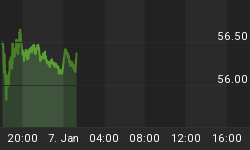Current Bond Market Visibility: Fair
Immediate-Term: Bullish
Near-Term: Bearish
Short-Term: Bearish
Intermediate-Term: Bullish
The Bullish Fix
A good number of bond market participants still believe that the Fed will be out of the market well into the second half of 2004, thereby ensuring monetary accommodation and engendering lower volatility in the bond market.
The persistent labor market weakness remains the headwind for the current attempt to stimulate greater growth in the US-economy. Recently released employment data showed that the only way to bring down initial claims or unemployment is by shrinking the labor force!
This weeks data calendar will be ham-and-cheese in comparison to the last week's gluttony of economic releases. The readings on factory and durable goods should lack any surprises while any sluggishness will firm up the bid. The lower volatility should help the market digest its past trading moves in relation to all its surroundings; resulting in consolidation around minor supports and less testing of major ones.
Although this week's treasury auction will raise a net of $16 billion, on settlement date the market will receive $21 billion in interest payments, thereby resulting in a $5 billion in net cash flows to the market.
The initial fury of MBS originator selling has very much exhausted its short-term ammunition. The market needs to be shocked with another 50bp higher in yields for the MBS rioting crowd to come back to the market.
The Bearish Fix
Last week's monsoon of economic release was a great challenge for the skeptics of economic recovery. The numbers across the board showed that the improvements in economic activities have started to gradually arrive and that the 3% to 4% economic growth forecasts for the third-quarter are becoming more realistic.
The bond market is removing from it monetary policy considerations - the previously talked about - a final 25bp rate cut by the Fed. The contracts on fed-funds are hovering around the 1% rate all through the second-half expiration dates.
Confirmed expectations for an expansive fiscal roll in the economy, given the pending boost to consumer spending from the recent tax cuts, and the recently reported 44% contribution of defense spending to real GDP growth - the highest since the Korean War. This acceleration in deficit spending has a negative effect on the bond markets through the higher supply of Treasuries, higher real rates, and eventually higher inflation rate.
The bond market is still retaliating to the communication mishap (or some called mischief) brought about by the Fed regarding the economic outlook and monetary policy operations. The bond market is creating uncomfortable financial conditions for the FOMC that are counter productive to their intended monetary accommodation.
The focus, nonetheless, will be on the $60 billion Treasury refunding this week ($24 bln. in the 3yr, and $18 bln. in the 5yr and the same size in the 10yr) that will raise $16 billion in net flows.
The Strategy Fix
After last week's 25bp plus run-up in yields across the curve and after the 75bp run-up in the 2yr yield, 118bp in the 5yr yield, and the 130bp that got added on the 10yr since June 13, 2003, one can start thinking about how cheap do we have to get in the short-term to readjust the curve and flatten it from what was a Fed-incited-fear about deflation pressures (some thinks it was a scheme!) to the current state of affairs where the Fed has retracted its deflation warnings and is currently defending its May 6, FOMC statement by using loosy-goosy statistical confidence intervals to justify their stretched regression coefficients.
We see the market moving from the dumping-bonds theme that prevailed over the past 40 days and entering the stage of just selling bonds. Bottom searching and downside risk will continue to dominate the market mentality for intermediate term.
We are keeping our relative short duration positions while tilting towards a more neutral duration pasture. We maintain our overweight in the cusp and premium coupon MBSs, as we seek the protection of negative convexity.
Many are talking about the 3.00% on the 5yr and the 4.25% on the 10yr as the fundamentally equilibrium levels on the curve for now. We, however, look for the 3.20% on the 5yr and the 4.5% to be the market equilibrium given the expected monetary policy, the current and expected inflation levels along with the failure of last week's various tests north of the these yields. Nonetheless, the talked about shocking moves to 4.00% on the 5yr and 5.00% on the 10yr remain in the tails of our probability distribution for the near-term and short-term.















